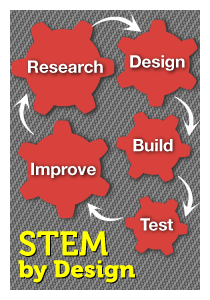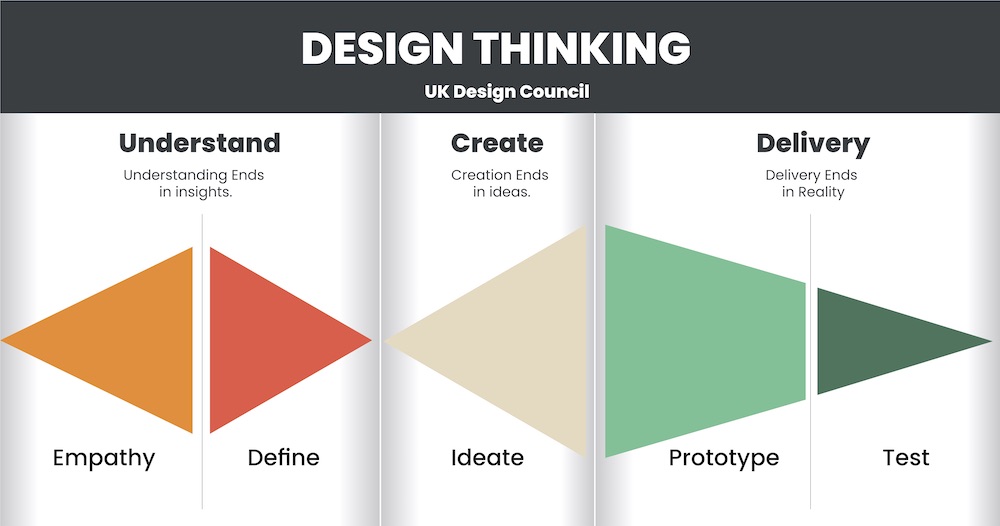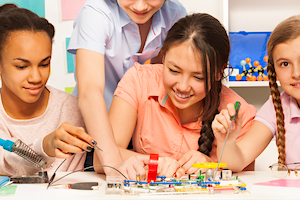Ready STEM Students for a Future of Creativity
A MiddleWeb Blog
 Why would you read a post about “design thinking” and “preparing kids for the 21st century workforce”? And why am I writing one?!
Why would you read a post about “design thinking” and “preparing kids for the 21st century workforce”? And why am I writing one?!
Over time these descriptors have drifted into the ranks of familiar catch phrases. When I see them I think, Okay – been there, read about that. I’m hoping you’ll keep reading this post because I have a different angle I want to share with you.
I recently helped design a STEM curriculum for middle school that our Business and Industry client believes is representative of what STEM needs to be about. Here comes the angle!
I’m a big proponent of using the Engineering Design Process (EDP) in STEM projects (see my logo above!). Turns out that while businesses emphasize a similar design approach, they concentrate closely on several skills we educators don’t always put at the top of the design list.
So… I’m thinking we might need to adjust our teaching focus as we continue our quest to equip kids to be workforce-ready employees.
The evolving, high-pressure world of business and industry
Just consider the alarming pace of change in our society. (Really, what hasn’t changed, even over the past 10 years? The world grows smaller while human needs and increasingly complex challenges loom larger.) Think about how these accelerating changes affect business and industry. Being able to create more efficient products is no longer enough.
Companies struggle to keep up with the demands for new products and creative solutions. Around the world there’s an upward trend in patents, copyrights, and trademark filings, and this adds additional pressure and a call for ever faster innovation.
Companies today must be adaptable, imaginative, and fast-paced if they’re to survive. Forward-looking business leaders want employees who can design answers for complex problems (including poverty, health, and famine) as well as for products and processes that bring users enjoyment and help them to be more productive.
Business and industry’s primary need? Creative innovators. In fact, creativity currently tops the list of the most in-demand soft skills in the workplace. The message business is hearing: Innovate or die. And creativity is the key to survival.
Design thinking in business
No surprise, then, that while the design process for manufacturing still stresses skills found in the EDP, it adds a different twist on how to get students where they need to be.
In a nutshell, here’s a look at three iterative skills the business model emphasizes. It’s worth noting that research shows (and businesses agree) that employees are best at using these skills as they work together in collaborative teams.
1. Empathy
Coworkers are poised to create innovative products (even products which do not yet exist) when they are able to respond to needs thoughtfully with real understanding. This requires two things:
► They must observe consumers to learn and appreciate how users interact with or are affected by a product or issue. These observations must happen with empathy. To the extent possible, they must identify with these users and be considerate and responsive. This means withholding judgment and shelving any preconceived notions of what the consumer needs.

Image by Gerd Altmann from Pixabay
► They must communicate with users and actively engage in discussions and exchanges with them. This helps coworkers gather ideas about the difficulties consumers are brushing up against and where they are struggling. This communication typically takes place throughout the product development cycle so designers can get consumer feedback on the product in process.
Interacting with empathy uncovers issues that consumers didn’t even realize they had or were unable to communicate. Once employees have a clear understanding of the situation, they can more clearly understand the human need behind the product they are designing.
2. Creative ideas
Creativity is a social process. After gathering essential information from the end users, coworkers use what they learned to generate new, creative ideas for addressing the problem or issue. Note that in this creative process all ideas are on the table. No idea is considered too “far out” to be a possibility. In fact, totally new ideas are welcomed.
Integrative thinking comes into play during this part of the process. Team members carefully analyze all options and combine different ideas into one best solution. They select the most promising one to pursue.
According to author Roger L. Martin, Integrative thinking involves taking two opposing ideas and producing a creative solution that joins the two and is superior to both. He describes a systematic process for doing this: (1) Articulate two opposing solutions. (2) Examine both closely, (3) Create new possibilities, and (4) prototype the new solutions. For more information on this, check out this article.
3. Innovative solutions
Now it’s time for co-workers to create a new, innovative product, service, or practice to address consumers’ needs. (Simply tweaking an existing product will have limited effects.) They use the creative solution selected and use an EDP-style process to turn it into a tangible outcome. If developing a product, prototyping will enable them to “play” with the completed product and find new imaginative ways for it to be modified and used.
 Shutterstock – click to enlarge
Shutterstock – click to enlarge
What can teachers do?
That’s our cue, teachers. Time to take another look at how we are equipping students to function successfully in their future world. We already use good design approaches for preparing kids, but maybe it’s time to shift our STEM approach to align more closely with current workforce needs. (Yes, again! No one is more creative and innovative than a resolute teacher focused on developing well-prepared students.)
With that in mind, developing student creativity = helping kids realize their innovative potential. How do you do that? Creativity is not distributed among a select few – it’s something that can be learned and nurtured. Are there guidelines for that?
Yes, but I’m seriously out of space in this post. (It’s my editor’s fault!) I’ll list a couple of articles that can get you started. But remember this: creativity is social and requires the right kind of supportive environment. Classroom dynamics must encourage creative thinking and give kids experience in connecting knowledge in new and different ways. A few things you can do to set the stage:
✻ Keep students engaged by making them feel valued and appreciated.
✻ Empower students and support risk-taking
✻ Help them broaden their expertise, deepen their knowledge, and learn creative techniques.
 ✻ Help them build good interpersonal skills and social interactions.
✻ Help them build good interpersonal skills and social interactions.
✻ Address student burnout, stress and work overload.
✻ Actively promote an emotional connection to the problem.
✻ Focus on creating empathy for the end users of the product or service.
✻ Develop your own skills at creating, coaching, and creating a safe environment for your students.
Simply put, all kids – now and when they become employees – should be designers who work to change or make something better.
Sources for further exploration
Design Thinking Resource Center
Cultivate Creativity in Your STEM Classroom
Creativity is Social: The Interpersonal Dynamics of Innovation in the Workplace (PDF) To download this PDF directly from the website, go to Creativity is Social.

































